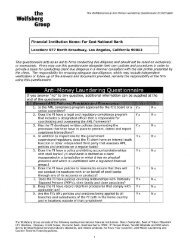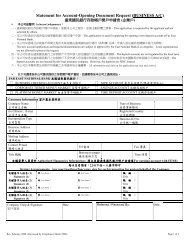2006 ANNUAL REPORT - Far East National Bank
2006 ANNUAL REPORT - Far East National Bank
2006 ANNUAL REPORT - Far East National Bank
Create successful ePaper yourself
Turn your PDF publications into a flip-book with our unique Google optimized e-Paper software.
The unrealized loss positions on the obligations of U.S. government sponsored enterprises, collateralizedmortgage obligations, and municipalities are a function of the volatility with interest rates in <strong>2006</strong> and2005. These securities are rated AAA by Standard and Poors with one-to-two year duration, andredeemable at maturity or when called at par. As of December 31, <strong>2006</strong> and 2005, the <strong>Bank</strong> did notrecognize any other than temporary impairment.Securities with carrying amounts of approximately $181,527,000 and $154,181,000 were pledged tosecure public deposits and for other purposes as required or permitted by law at December 31, <strong>2006</strong> and2005, respectively.3. LOANS AND ALLOWANCE FOR LOAN LOSSESLoans consist of the following at December 31:<strong>2006</strong> 2005Real estate $ 772,742,335 $ 759,629,239Commercial 292,002,083 238,927,604Construction 143,134,907 134,614,733SBA 14,187,797 18,125,329Installment and credit card 406,818 389,2591,222,473,940 1,151,686,164Less:Allowance for loan losses 13,280,855 11,937,392Deferred loan fees—net 2,161,719 2,572,622Premiums—net 145,043 260,139Loans—net $ 1,206,886,323 $ 1,136,916,011Loans to borrowers are collateralized by a variety of properties, primarily located in California. As ofDecember 31, <strong>2006</strong> and 2005, these loan balances consisted of commercial real estate of approximately$548,769,000 and $509,637,000, multi-residential property of $67,283,000 and $80,564,000, and realestate under construction of $143,135,000 and $134,615,000. The ability of the <strong>Bank</strong>’s customers tohonor their loan agreements is dependent, in part, upon the health of the real estate market, as well as thegeneral economy of the <strong>Bank</strong>’s market area. Should the real estate market experience an overall declinein property values, the ability of borrowers to make timely scheduled principal and interest payments onthe <strong>Bank</strong>’s loans may be adversely affected and, in turn, may result in increased delinquencies andforeclosures. In the event of foreclosures under such conditions, the value of the property acquired maybe less than the appraised value when the loan was originated and may, in some instances, result ininsufficient proceeds upon disposition to recover the <strong>Bank</strong>’s investment in the foreclosed property.Furthermore, although most of the <strong>Bank</strong>’s trade finance activities are related to trade with Asia, all of the<strong>Bank</strong>’s loans are made to companies domiciled in the United States of America. The <strong>Bank</strong> hashistorically made three types of credit extensions involving direct exposure to the Asia Pacific region(Taiwan, China, Vietnam) economy: commercial loans to U.S. affiliates/subsidiaries/branches ofcompanies headquartered in Asia Pacific region, acceptances with Asia Pacific banks, and standbyletters of credit issued by Asia Pacific banks. In certain instances, standby letters of credit issued by AsiaPacific region banks support the loans made to the U.S. affiliates or branches of Asia Pacific regioncompanies, to which the <strong>Bank</strong> has extended loans. The percentages to other individual Pacific Rimcountries are relatively small in relation to the loans involving country risk. As a result, with theexception of Asia Pacific region, the <strong>Bank</strong> does not believe it has significant indirect country riskexposure to any other Pacific Rim countries.24





